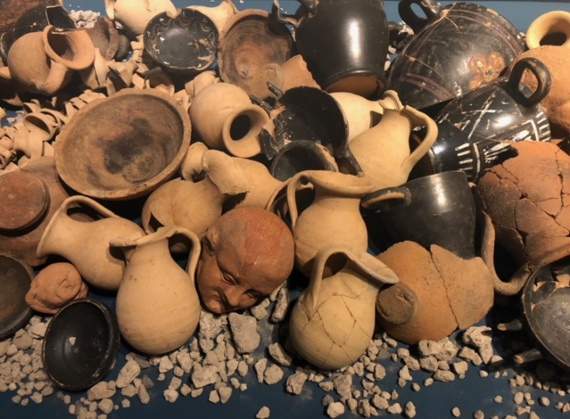Ancient Stabia lives again at the Antiquarium of Pompeii: it's the exhibition In Search of Stabia
It opened on July 31, 2018, and runs until January 31, 2019, in the spaces of theAntiquarium of Pompeii, the exhibition In Search of Stabia, a review that aims to revive ancient Stabia through the evidence represented by the findings of the necropolis of Madonna delle Grazie and the extra-urban sanctuary in the locality of Privati. These are two contexts of great importance for the reconstruction of the settlement dynamics of the Stabian territory and its historical events in pre-Roman times.
The necropolis of Madonna delle Grazie, with about three hundred tombs distributed over an area of about fifteen thousand square meters, all dated between the second half of the seventh and the end of the third century B.C., represents the oldest stable occupation of the territory and is therefore a valuable source of information on the inhabitants of the ancient centers that surrounded Pompeii. On the other hand, the place of worship in the locality of Privati documents a previously unpublished aspect of the history of ancient Stabia, namely the presence of an extra-urban sanctuary in the second half of the fourth century BCE.
The ancient votive deposit, located on a terrace of the Lattari Mountains sloping panoramically toward the Gulf of Stabiae, anciently marked the southern boundary of the Stabian territory, in a strategic position controlling the route that connected the Sarno valley and the Sorrento-Amalfi area. In the center of the terrace a large pit was identified with votive material, often intentionally fragmented before being deposited, mixed with burned soil and animal bone offerings. The different types of votive offerings, from ceramics to votive terracottas to antefixes, signal the deity’s strong connection to the female sphere and place the sanctuary in a network of places of worship that dotted the Sorrento Peninsula, from the Doric temple at Pompeii to the Athenaion at Punta della Campanella. The objects that the public can find in the exhibition itinerary outline the identity of the deceased and attest to the adoption of forms of wine consumption linked to the Greek and Etruscan worlds. The artifacts also testify to the presence in Campania of new peoples such as the Etruscans who, between the end of the seventh and the beginning of the fourth century B.C., triggered profound transformations in territorial arrangements and settlement dynamics. In this period, prompted also by the arrival of foreign peoples, the local populations of the innermost areas of the Sarno plain and the Lattari Mountains in fact pushed as far as the Gulf of Naples and opened up to new contacts. The necropolis of Madonna delle Grazie chronicles this complex phase of transformation.
“This exhibition,” says the superintendent of Pompeii, Massimo Osanna, “brings light to a place that has been too long forgotten, which is the Stabian antiquarium that was a glorious place in the 1960s for the extraordinary materials it contained, then closed due to problems with the building’s usability. To this day it has been the inadequate container of material no longer usable by the public.”
The artifacts, ex votos, votive terracottas, signal the strong connection with the female sphere and place the sanctuary in a network of places of worship that dotted the Sorrento Peninsula, from the Doric temple of Pompeii to theAthenaion of Punta della Campanella. Osanna and Mayor Gaetano Cimmino said the artifacts will later be placed in the Reggia di Quisisana, which will house the museum, research center and superintendency offices. For all information you can call +39 081 8575327 or visit the Pompeii Archaeological Park website.
 |
| Ancient Stabia lives again at the Antiquarium of Pompeii: it's the exhibition In Search of Stabia |
Warning: the translation into English of the original Italian article was created using automatic tools. We undertake to review all articles, but we do not guarantee the total absence of inaccuracies in the translation due to the program. You can find the original by clicking on the ITA button. If you find any mistake,please contact us.




























